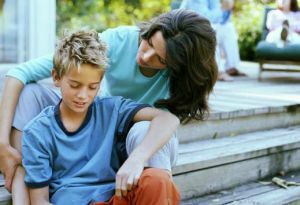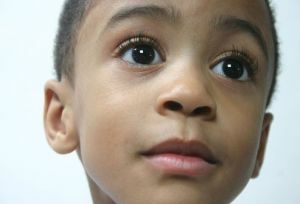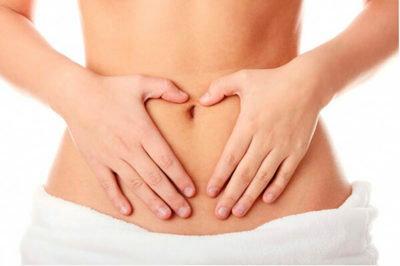 Absence - is an non-convulsive attack that occurs when the consciousness is briefly turned off.
Absence - is an non-convulsive attack that occurs when the consciousness is briefly turned off.
Most often, absences begin in children after 4 years and eventually pass, others can suspect an attack in a person by a stopped look, a flutter of the eyelids, in some cases by involuntary masticatory movements.
Absenses are usually referred to as mild epileptic seizures, it is believed that this is one of the first signs of the development of epilepsy.
If you pay attention in time to such a condition of the child and pass the diagnosis with treatment, then you can prevent the development of a more severe pathology.
Content
- The characteristic absence
- clinical picture
- Classification attacks
- reasons for absences
- Features absence seizures in children
- Clinical manifestations
- disease diagnosis
- Treatment attacks
- Forecast and complications
- Prevention
- Video: How come absences from
children The characteristic absence
absences -it is an attack in which a person's consciousness completely or partially does not react to the surrounding reality.
Absenses are characterized by the fact that the attack lasts from a few seconds to a half-minute of the and is most often not noticed by others. The recovery process also takes place in a few seconds, usually a person continues to do what he did before turning off consciousness.
Absence can be characterized by three typical for this type signs:
- Attack lasts no more than a few seconds.
- There is no reaction to stimuli from the outside.
- After absence, the person believes that everything was in order. That is, the attack does not remember the patient himself.
A characteristic feature of this type of disconnection of consciousness can be called a large number of absences in both children and adults. In a day, consciousness can be cut off from ten to hundreds of times.
Clinical picture of
A typical picture in absences is considered to be missing sight, eyelids flutter, skin discoloration, in some cases, and minor  lifting of the upper limbs.
lifting of the upper limbs.
Part of the people have complex absences, accompanied by bending the body backwards, with stereotyped motions.
After a complex attack, a person usually feels that he has suffered something unusual.
Classification of seizures
Absenses are classified according to the severity of the leading symptoms:
- Typical absences occur without preliminary signs, the patient seems to be stony, the gaze is fixed at one point, the movements made before this cease. Completely mental state is restored in a few seconds.
- Atypical absences are characterized by a gradual onset and termination and a larger clinical picture. The patient can observe bending of the body, falling objects from the hands, automatism in the movements. Reducing the tone often leads to an unexpected drop in the body.
In turn, complex, atypical absences are divided into several forms:
- Myoclonic absences - short-term complete or partial loss of consciousness, accompanied by sharp, periodic shocks throughout the body. Myoclonias are usually bilateral and most often appear on the face - the corners of the lips, eyelids, and muscles near the eyes twitch. The object in the hands during an attack falls out.
- Atonic absences are characterized by a sharp weakening of muscle tone. Accompany it can fall, after which the patient slowly rises. Sometimes weakness occurs only in the muscles of the neck, because of which the head hangs on the chest. In rare cases, during such an attack, involuntary urination is detected.
- Akinetic absence is a complete disconnection of consciousness in combination with immobility of the whole body. Often such absences are found in children under the age of 9 years.
- Absenses with vegetative manifestations - for this form, in addition to disabling consciousness, urinary incontinence, a sharp increase in pupils, and hyperemia of the facial skin are characteristic.
It is also accepted to subdivide absences according to age:
- childless first time registered up to 7 years;
- juvenile absences are detected in adolescents 12-15 years.
Causes of absence
 Seizures of absence in many cases are often not noticed and therefore the nature of their origin is difficult to identify.
Seizures of absence in many cases are often not noticed and therefore the nature of their origin is difficult to identify.
Some researchers put forward a genetic predisposition, along with the activation of the brain cells at a certain moment.
You also need to subdivide the true and false absences. From a false person it is easy to bring out by touching, addressing, harsh shouting, with a true patient does not react to external changes.
For possible reasons of absence, is accepted to refer:
- hereditary predisposition;
- hyperventilation of the lungs, which changes the level of oxygen and carbon dioxide and the body experiences hypoxia;
- imbalance of essential chemicals in the brain;
- poisoning with toxic substances.
Even in the presence of all these provoking factors, the absence of development does not always develop, the probability of unconsciousness increases with the following diseases:
- with congenital convulsive disorder;
- pathologies of the nervous system;
- after encephalitis or meningitis;
- with bruises of the brain and craniocerebral trauma.
Absence can be one of the characteristic manifestations of epilepsy at any age.
 It is useful to know where the main foci of gliosis in the brain are located and why this process develops in the body. In modern environmental conditions and difficult living conditions, hypertensive hydrocephalic syndrome in adults and children occurs more and more often. How to deal with this phenomenon.
It is useful to know where the main foci of gliosis in the brain are located and why this process develops in the body. In modern environmental conditions and difficult living conditions, hypertensive hydrocephalic syndrome in adults and children occurs more and more often. How to deal with this phenomenon. Absence characteristics in children
Absence in children is considered the most frequent manifestation of epileptic seizure.
To suspect the appearance of an attack can be on the same type of movements in the hands, smacking lips, detached eyes. 
Children with schoolchildren, when registering several absences a day, there is a decline in academic performance, absent-mindedness, psycho-emotional sphere suffers.
Children with seizures should constantly be under close scrutiny, as loss of consciousness can happen at the most inopportune moment - when swimming, crossing a busy road, riding a bicycle.
Clinical manifestations of
The first characteristic sign of the absence of is , a disorder of consciousness, expressed in its complete disconnection or fogging.
Making a move, a sick person can stop abruptly, and the facial expression does not change at the same time, the look is directed to the space, jerking of the eyelids, movement of the lips can be noted.
The attack lasts an average of three seconds, after which the person continues the movement.
Complex absences can be accompanied by falling objects from the hands, twitching different muscle groups, tilting the trunk back, visible myoclonias on the face.
In an atonic form of an attack a person can fall due to weakness in muscles. Absenses can be expressed in repetition of automatic movements - a person can touch something, perform chewing movements, roll his eyes.
Diagnosis of
When making a diagnosis it is important to differentiate true absences from other brain pathologies. The following scheme is used:
- EEG.This procedure records the waves of brain activity at the time of an attack, for which it is stimulated by artificial means.
- Blood test for the presence of toxic components and the level of microelements.
- MRI of the brain is necessary to exclude tumors, strokes.
Treatment of seizures
Treatment of identified absences refers to the most effective prevention of , aimed at preventing the development of true epilepsy. In almost 90% of cases, attacks can be completely eliminated, but only with timely access to a doctor.
 Scheme of therapy is selected after repeated attacks, since the first absence can be triggered by toxic substance, poisoning, trauma.
Scheme of therapy is selected after repeated attacks, since the first absence can be triggered by toxic substance, poisoning, trauma.
It is believed that two to three absences per year need not be treated, only needs to provide the body with a full sleep , less worry, avoid physical and mental fatigue.
Treatment is prescribed if absences are repeated all the time and can be life-threatening when crossing streets, swimming pool occupations. From the drug treatment anticonvulsants and soothing are chosen.
It is important for a patient to avoid situations where the appearance of an attack is most likely. This disco with flickering lights and noise, not recommended electroprocedures, alcohol consumption.
Reduces the number of attacks calm environment, walking in the fresh air, the predominant use of plant foods. An adult patient should refuse to work at night and from the management of transport.
If absences are caused by an identified tumor, then surgery is indicated to remove the tumor.
Prognosis and complications
A favorable prognosis is usually observed with absences at the following conditions:
- Early onset of seizures. Children's absences in most people are up to 20 years.
- In the presence of typical absences, not accompanied by myoclonias, automaticity in movements, falls.
- With good treatment, under the influence of which the absences completely pass.
If treatment does not help, and seizures are repeated several times a day, then mental activity suffers, social adaptation in the team is disrupted.
Prevention
Specific prevention of the first development of an attack does not exist, since the absence can be caused by different internal and external causes.
In order to prevent frequent deactivation of consciousness, it is necessary to fully rest, avoid negative emotions and injuries.
Video: How the absences occur in children
Epileptic absense in a patient with epilepsy. It is clearly shown what happens in such cases.



